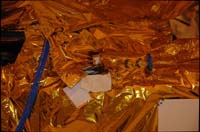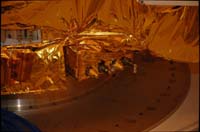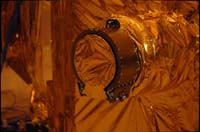 |
 |
 |
|
The instrument that provides the highest spatial resolution on New Horizons is LORRI -Long Range Reconnaissance Imager - it consists of a telescope with a 8.2-inch (20.8-centimeter) aperture that focuses visible light onto a charge coupled device (CCD).
|
Two of the hydrazine thrusters near final thermal blanket work.
|
Four of the 16 hydrazine thrusters
|
 |
 |
 |
|
Shown is the science instrument Alice as it is assembled for flight. Alice is an ultraviolet imaging spectrometer that will probe the atmospheric composition of Pluto.
|
Closeup of the science instrument Ralph. Ralph's main objectives are to obtain high resolution color maps and surface composition maps of the surfaces of Pluto and Charon.
|
Shown is PEPSSI, the plasma-sensing instrument. The Pluto Energetic Particle Spectrometer Investigation (PEPSSI) will search for neutral atoms that escape Pluto's atmosphere and subsequently become charged by their interaction with the solar wind.
|
 |
 |
 |
|
The Solar Wind Analyzer around Pluto (SWAP) instrument will measure charged particles from the solar wind near Pluto to determine whether Pluto has a magnetosphere and how fast its atmosphere is escaping.
|
One half of the flight fairing. The silver panels are for acoustical insulation.
|
The other half of the flight fairing
|